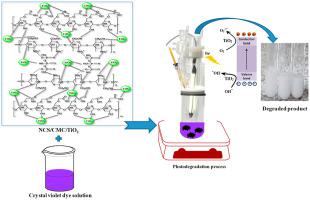Environmental Research ( IF 7.7 ) Pub Date : 2021-09-13 , DOI: 10.1016/j.envres.2021.112047 S Sugashini 1 , T Gomathi 1 , R Aruna Devi 1 , P N Sudha 1 , K Rambabu 2 , Fawzi Banat 2

|
Development of novel bionanomaterials for water and wastewater treatment has gained increased attraction and attention in recent times. The present study reports an effective biocomposite-based nano-photocatalyst comprised of nanochitosan (NCS), carboxymethyl cellulose (CMC), and titanium dioxide (TiO2) synthesized by sol-gel technique. The as-prepared NCS/CMC/TiO2 photocatalyst was systematically characterized by X-ray diffraction, Fourier Transform Infrared spectroscopy, Scanning Electron Microscopy with energy dispersive X-beam spectroscopy, Differential scanning calorimetry (DSC), and Thermogravimetric analysis (TGA). Photocatalytic degradation of the crystal violet (CV) dye using this nano photocatalyst was studied by varying the irradiation time, catalyst dosage, feed pH, and initial dye concentration. Further, the kinetic analysis of dye degradation was explored using the Langmuir−Hinshelwood model, and a plausible photocatalytic mechanism was proposed. The modification of TiO2 using NCS and CMC accelerated photocurrent transport by increasing the number of photogenerated electrons and holes. Overall, the study indicated the excellent photocatalytic performance of 95% CV dye degradation by NCS/CMC/TiO2 than the bare inorganic TiO2 photocatalyst under visible light irradiation.
中文翻译:

纳米壳聚糖/羧甲基纤维素/TiO2生物复合材料用于可见光诱导的结晶紫染料光催化降解
近年来,用于水和废水处理的新型生物纳米材料的开发受到越来越多的关注和关注。本研究报告了一种有效的基于生物复合材料的纳米光催化剂,该催化剂由通过溶胶-凝胶技术合成的纳米壳聚糖(NCS)、羧甲基纤维素(CMC)和二氧化钛(TiO 2 )组成。所制备的 NCS/CMC/TiO 2通过 X 射线衍射、傅里叶变换红外光谱、具有能量色散 X 射线光谱的扫描电子显微镜、差示扫描量热法 (DSC) 和热重分析 (TGA) 系统地表征了光催化剂。通过改变照射时间、催化剂用量、进料 pH 值和初始染料浓度,研究了使用这种纳米光催化剂对结晶紫 (CV) 染料的光催化降解。此外,使用 Langmuir-Hinshelwood 模型探索了染料降解的动力学分析,并提出了一种合理的光催化机理。TiO 2的改性使用 NCS 和 CMC 通过增加光生电子和空穴的数量来加速光电流传输。总体而言,该研究表明,在可见光照射下,NCS/CMC/TiO 2对 95% CV 染料降解的光催化性能优于裸无机 TiO 2光催化剂。











































 京公网安备 11010802027423号
京公网安备 11010802027423号